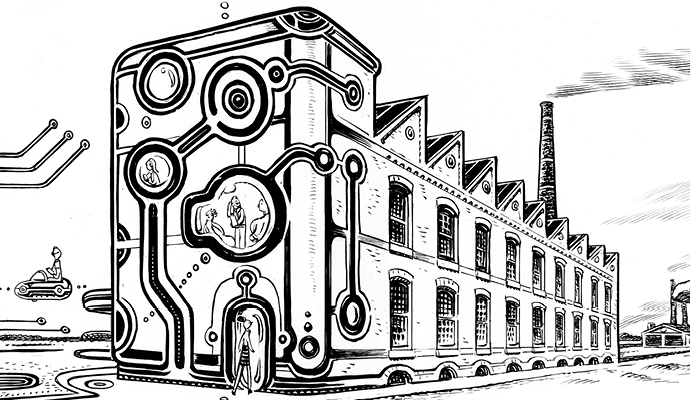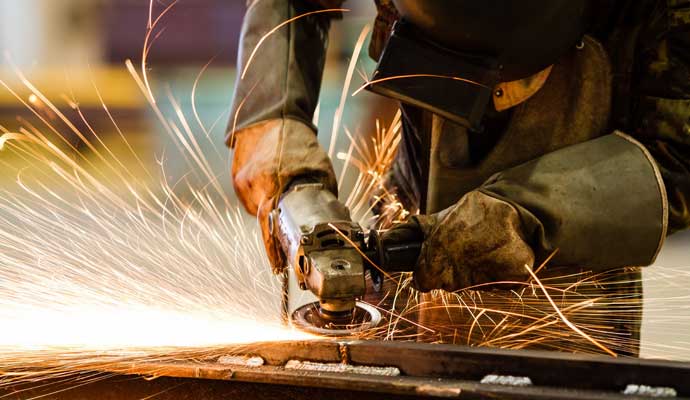Not All Tech Destroys Jobs
As one McDonald’s location proves, investing in expensive equipment that substitutes for some labor is a proactive, productivity-enhancing measure.
I noticed a curious thing about the McDonald’s last week at Amsterdam’s Schiphol Airport. And no, it wasn’t that the locals were dipping the fries in mayonnaise. Rather, it was the setup. You placed orders at one of a dozen kiosks arrayed near the counter, swiped a debit card, and then waited for the crew members to call your number when the order was ready. This McDonald’s was remarkably busy. The action behind the counter was as frenzied as at any busy outpost in the states: a dozen uniformed workers putting together fries, sodas, and burgers as hungry customers waited. But not one employee was engaged in taking orders.
This is productivity growth in action — more output with slightly less human labor. But in the U.S., the presence of more machines at fast-food joints is often positioned as a job-destroying disruption, or wielded as a threat. It’s common to hear leaders in the quick-food-service industry complain that if minimum wages are set too high, they might have to replace people with machines. Earlier this year, a former McDonald’s president said that moving toward a US$15 minimum wage would push restaurant franchises to buy expensive robots and would “cause job loss across this country like you’re not going to believe.” And of course, in high-cost San Francisco (where else?), a robot-powered burger joint is on the way.
But here’s the thing: The way the Amsterdam airport McDonald’s works actually makes more sense than the way McDonald’s and its competitors run most of their outlets in the U.S. — with humans taking all the orders. It’s not like wages in the Netherlands are that much higher than they are in the U.S. (the Netherlands has a minimum wage that varies by age, but translates to about $8 an hour for a 21-year-old at existing exchange rates.) Buying expensive equipment that substitutes for some labor is precisely what all types of businesses should be doing.
Indeed, the restaurant industry has already embraced such labor-saving technology. Many chains have been deploying kiosk-based in-store ordering systems. And the rise of Seamless as a lunch utility for office drones means a machine is effectively performing this function: The website takes orders and accepts payments electronically for thousands of restaurants. So it’s kind of mystifying why more restaurant and business owners don’t invest in labor-saving technology — as a proactive, productivity-enhancing measure — and instead wield it as a threat.
There were still plenty of people working at the McDonald’s in the Amsterdam airport — they just weren’t taking orders and collecting payments. There, as at every restaurant and every workplace, human beings work alongside machines. And a hallmark of modern economies is that companies use increasingly intelligent equipment to do some of the work — especially the repetitive and annoying components — that had once been the exclusive province of people. In the 19th century, the reaper didn’t make farmers or farm work obsolete; it just meant that people no longer needed to cut grain by hand. The steam-powered assembly line didn’t put factory workers out of a job; it just meant workers could spend their time putting cars together rather than moving materials from station to station. And even though ATMs do a lot of the banking system’s work of accepting deposits and dispensing cash, the nation’s tens of thousands of bank branches are still staffed by tellers and other employees.
A hallmark of modern economies is that companies use increasingly intelligent equipment to do some of the work.
So, yes, you can look at the aggressive deployment of IT and equipment as displacing and substituting for comparatively expensive human labor. The other way to look at it is that it frees people up to do other higher-value-added tasks in the workplace. More significantly, taking human labor out of the equation often creates productivity gains for thousands or even millions of customers. For example, working at a tollbooth may be a secure job. But whatever gains the economy gets from having people making change at tollbooths are more than offset by the loss of time that results when other people have to wait in traffic to enter a toll road. Starting in October, the Massachusetts Turnpike Authority will shift to entirely automatic tolls. Machines will do all the work of collecting tolls, and toll collectors either will be reassigned to other positions within the authority or will have to find new jobs. But traffic will flow more easily, leading to big gains in efficiency for truckers and people getting to work, and less waste of fuel.
The fears of a jobless future are based on the idea that many routine service jobs will disappear. That’s understandable, especially when business executives wield machines as threats. But the reality is that components and whole classes of jobs have been disappearing for decades (know any stenographers?) and will continue to disappear. Of course, there are lots of people who would be working today if machines hadn’t usurped their positions doing repetitive tasks. But that’s not even half the story. Consider this: The U.S. has a record number of payroll jobs and an unemployment rate of under five percent. What’s more, it seems like there are lots of jobs — including many that involve repetitive tasks — sitting there waiting for people (not machines) to do them. The Bureau of Labor Statistics’s JOLTS report shows that there were some 5.6 million jobs open in the U.S. at the end of June 2016, close to a record.
If only we could devise and deploy machines that would more effectively match individuals seeking work with employers looking to hire.





